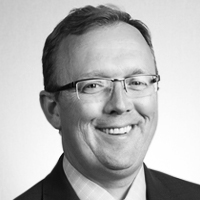Question
How does HyperSound directed audio solution work?
Answer
The first step for creating sound through HyperSound technology is to form an ultrasonic beam. Acoustic beaming is an effect that comes about by traditional acoustics through the ratio of speaker size to emitted wavelength. When this ratio is large, sound spreads out from the speaker and fills the nearby area. When this ratio is small, a beam is formed.
Traditional audio wavelengths are large. Middle-C on a piano has a fundamental wavelength of over 4 ft. In contrast, even an extremely large speaker (the part that vibrates) is rarely more than 1 ft. in diameter. As a result, this causes the sound waves to spread out. The situation is analogous to ocean waves in a marina. Despite no directline access to the open ocean, surface waves manage to bend around corners and make it to every last corner. This spreading of long wavelengths is called diffraction and is an everyday phenomenon that we experience with regular sound.
HyperSound, in contrast, uses the extremely small wavelengths of ultrasound to create an audio beam. At 100khz, the wavelength of sound is 0.13 inches. With an emitter size of several inches, we fall into the opposite limit. Much like how shining a flashlight through a quarter-size hole produces a quarter-size beam of light, our HyperSound emitter produces a emitter-size beam of ultrasound. HyperSound travels in a focused direction along the beam, unlike typical point source loudspeakers that emit sound waves in all directions. At 1khz and 10khz (regular audio frequencies) an emitter the size of that employed by HyperSound would create a wide-angle dispersion but at 100khz the beam stays tightly collimated. The next step to create HyperSound audio is to exploit the nonlinearity of air itself. Doing this creates sound from ultrasound and only does so within the tightly collimated beam. Figure 1 displays a functional diagram of HyperSound's audio beam system.

Figure 1. Diagram of HyperSound Process. First, the emitted ultrasonic wave is inaudible, but as it impresses audio signals onto the carrier in the air, the audio signal is demodulated by the parametric array effect and becomes audible. This demodulated audio wave retains the directivity of the ultrasonic wave, thus producing an audio beam.
HyperSound technology is the first and only directed audio solution of its kind designed specifically for the hearing healthcare industry. As indicated by clinical (Mehta, 2015) and preference (Taylor et al., 2015) research, HyperSound Clear™ improves clarity and speech intelligibility for those with hearing loss. Key innovations such as HyperSound’s patented DSP processing and proprietary emitter design have made way for a truly clear, optimized audio experience unlike anything else currently available.
This Ask the Expert is an excerpt from the HyperSound white paper entitled, HyperSound Clear Technology. For more information about HyperSound, visit www.hypersoundhearing.com
References
Mehta, R.P. (2015, January) Novel ultrasonic sound carrier significantly improves speech discrimination in subjects with hearing loss. Otology/Neurotology Scientific Session presented at the Combined Sections Meeting of the Triological Society. San Diego, CA. In this study, ten patients with mild to severe hearing loss in a single-blind, randomized cross-over study demonstrated improvement in sound clarity, measured with standard speech tests, over conventional speakers at 70 dB at 1 meter, including in background noise.
Taylor, B., Hartenstein, R., & Gruttadauria, S. (2015). Patient preferences for a directed audio system. Hearing Review, 22(10), 28. Survey of 58 adults exposed to 2 minute demonstration of HyperSound directed audio with 79% indicating the listening experience enhanced the ability to hear and understand speech.

